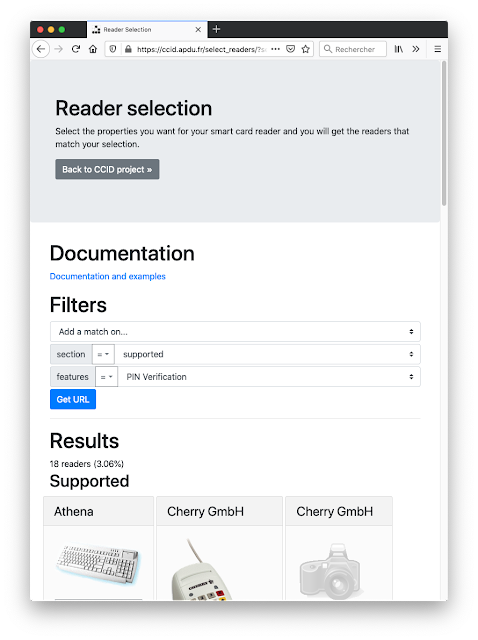Reader Selection: new field "section", new operator "≠"
In 2015 I presented the service Reader selection in the article "Reader Selection: find the smart card reader you search".
This service allows you to selected specific readers my list of 589 CCID readers.
Field "section"
It is now possible to select readers according to the field "section". This field can have 4 values: supported, shouldwork, unsupported, disabled. It will restrict the search to readers in the selected section.
For example if you want to list all the readers that can do PIN verification (pinpad readers) and that are in the supported list you use https://ccid.apdu.fr/select_readers/?section=supported&features=PIN%20Verification and you will get the 18 (as of now) readers that match these 2 criteria.
Operator "≠"
Previously, the possible operators were:
- = strict equality (for number or string)
- ~ match the head of a string
- ≤ lesser or equal
- ≥ greater or equal
I added a new operator "≠" for different.
For example if you want to list all the readers that can do PIN verification (pinpad readers) and that are NOT in the supported list you use https://ccid.apdu.fr/select_readers/?section%E2%89%A0supported&features=PIN%20Verification and you will get the 65 (as of now) readers that match these 2 criteria.
Combination
As before you can combine more than once the same selection field. If you want to list the pinpad readers that are NOT in the supported list and that are also NOT in the disabled list you use https://ccid.apdu.fr/select_readers/?section%E2%89%A0supported&features=PIN%20Verification§ion%E2%89%A0disabled and you get the pinpad readers that are in the shouldwork list OR in the unsupported list.
This "≠" operator is a way to get an OR combination that is otherwise not possible. If you have 4 values A, B, C or D and you want to use (A or B) then you can use (NOT C AND NOT D).
Conclusion
This service is very useful to select readers will a particularity. Of course you need to know what you are looking for.
If you want to know more about each of the USB CCID fields I suggest you have a look at my articles from "CCID descriptor statistics". You will learn what each CCID field is used for.
